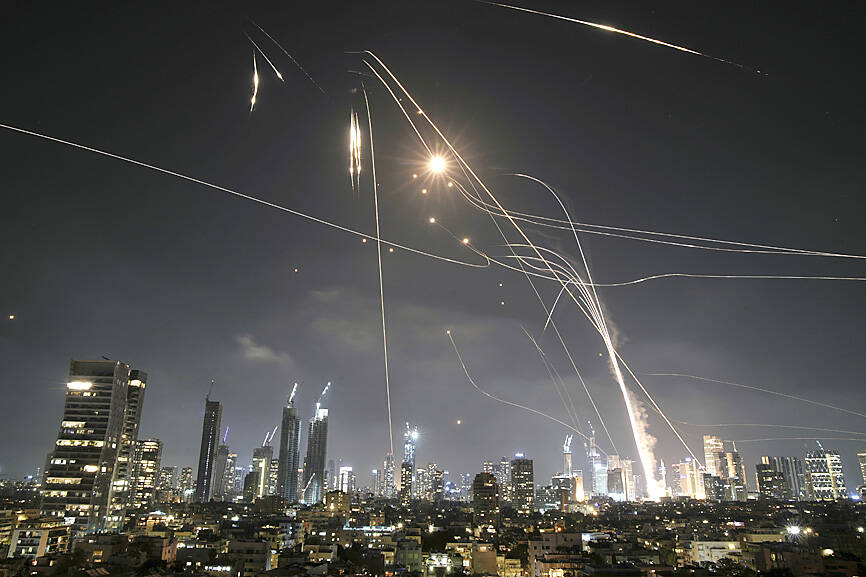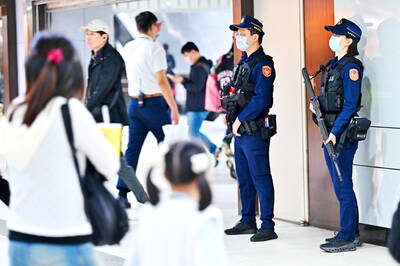Iran fired hundreds of ballistic missiles at Israel in response to an unprecedented attack on its nuclear facilities, escalating a conflict between sworn enemies that threatens to engulf the oil-rich Middle East.
The Islamic Republic targeted Israeli cities with multiple waves of missiles and a barrage of drones starting Friday evening, some of which breached the country’s air defenses. US forces helped shoot down the projectiles.
Three people were killed in the Tel Aviv area and at least 40 were injured in multiple strikes, according to police and emergency services.

Photo: AP
There was video footage of at least one large explosion in Tel Aviv and reports of blasts over Jerusalem. The full extent of the damage is still being assessed.
Israel’s air defense systems, including the Iron Dome and David’s Sling, boast an interception rate upward of 90 percent. If combined at varying altitudes, the chance of a successful shoot-down increases exponentially.
Israel, which killed top Iranian generals and badly damaged key military infrastructure with its first strikes overnight on Thursday, continued targeting Iran’s defense arrays on Friday and early yesterday.
More than 200 aircraft participated in Israel’s initial operation that hit about 100 locations. Iran’s ambassador to the UN, Amir Saeid Iravani, said 78 people were killed and more than 320 people have been wounded so far across the country.
Several residential buildings in Tehran’s suburbs were hit, Iranian media said.
The intensity of the fighting represents a turning point for Israel and Iran, testing new limits in terms of their aggression and willingness to escalate.
The fighting also casts doubt on the future of US negotiations with Iran on a deal to limit the country’s nuclear activities.
“The other side has done something that makes dialogue meaningless,” Iranian Ministry of Foreign Affairs spokesman Esmaeil Baghaei said, although he did not specify that a sixth round of talks scheduled to take place in Oman today would be called off.
Further escalation — particularly any targeting of US military or diplomatic facilities in the region — could rally domestic political support for Iran’s rulers and dramatically intensify the conflict. It is unclear if Tehran is entertaining last-resort options — such as blocking the Strait of Hormuz, one of the world’s vital oil arteries.
Iranian supreme leader Ayatollah Ali Khamenei vowed to “act forcefully” in a prerecorded video message carried by state TV.
Israel “should not think that it is over. We won’t allow them to escape unscathed from this great crime they have committed,” he said in a statement released after Iran started its retaliation.
The semi-official Fars news agency cited an unnamed military official as saying the conflict would soon “expand” beyond Israel to US bases in the region.

The US government has signed defense cooperation agreements with Japan and the Philippines to boost the deterrence capabilities of countries in the first island chain, a report by the National Security Bureau (NSB) showed. The main countries on the first island chain include the two nations and Taiwan. The bureau is to present the report at a meeting of the legislature’s Foreign Affairs and National Defense Committee tomorrow. The US military has deployed Typhon missile systems to Japan’s Yamaguchi Prefecture and Zambales province in the Philippines during their joint military exercises. It has also installed NMESIS anti-ship systems in Japan’s Okinawa

TRAGEDY STRIKES TAIPEI: The suspect died after falling off a building after he threw smoke grenades into Taipei Main Station and went on a killing spree in Zhongshan A 27-year-old suspect allegedly threw smoke grenades in Taipei Main Station and then proceeded to Zhongshan MRT Station in a random killing spree that resulted in the death of the suspect and two other civilians, and seven injured, including one in critical condition, as of press time last night. The suspect, identified as a man surnamed Chang Wen (張文), allegedly began the attack at Taipei Main Station, the Taipei Fire Department said, adding that it received a report at 5:24pm that smoke grenades had been thrown in the station. One man in his 50s was rushed to hospital after a cardiac arrest

ON ALERT: Taiwan’s partners would issue warnings if China attempted to use Interpol to target Taiwanese, and the global body has mechanisms to prevent it, an official said China has stationed two to four people specializing in Taiwan affairs at its embassies in several democratic countries to monitor and harass Taiwanese, actions that the host nations would not tolerate, National Security Bureau (NSB) Director-General Tsai Ming-yen (蔡明彥) said yesterday. Tsai made the comments at a meeting of the legislature’s Foreign Affairs and National Defense Committee, which asked him and Minister of National Defense Wellington Koo (顧立雄) to report on potential conflicts in the Taiwan Strait and military preparedness. Democratic Progressive Party (DPP) Legislator Michelle Lin (林楚茵) expressed concern that Beijing has posted personnel from China’s Taiwan Affairs Office to its

PUBLIC SAFETY: The premier said that security would be tightened in transport hubs, while President Lai commended the public for their bravery The government is to deploy more police, including rapid response units, in crowded public areas to ensure a swift response to any threats, President William Lai (賴清德) said yesterday after a knife attack killed three people and injured 11 in Taipei the previous day. Lai made the remarks following a briefing by the National Police Agency on the progress of the investigation, saying that the attack underscored the importance of cooperation in public security between the central and local governments. The attack unfolded in the early evening on Friday around Taipei Main Station’s M7 exit and later near the Taipei MRT’s Zhongshan